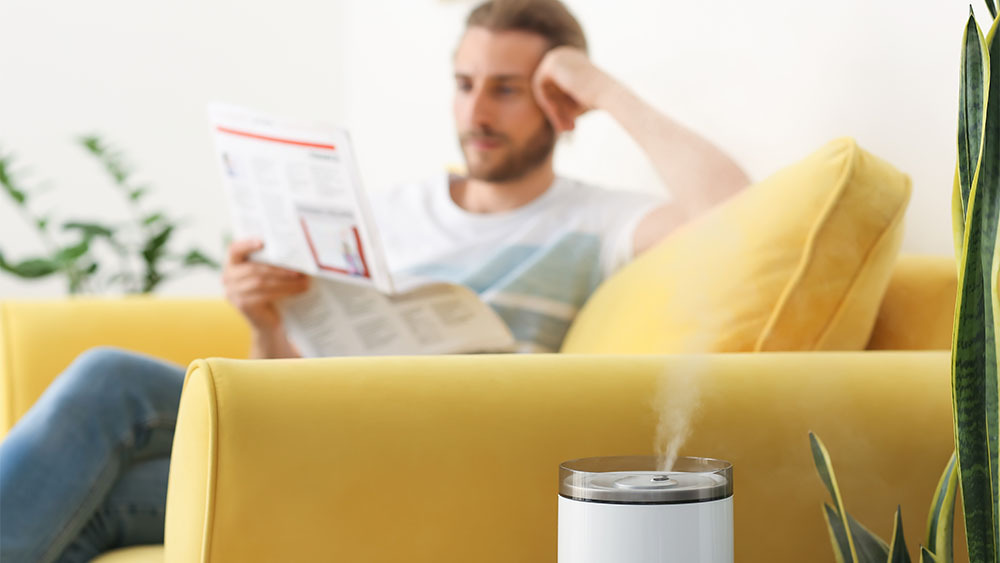
Key Takeaways
- A humidifier helps maintain ideal humidity levels (30-50%) to prevent dryness and allergies.
- The best place to put a humidifier is on a stable, elevated surface in a central location of your living space.
- When installing a humidifier, factor in room size, airflow, and safety to ensure efficient moisture distribution.
Humidity plays a vital role in maintaining your home environment. Ideally, the humidity in your home should be around 30-50%. However, it can easily dip to 20% or lower if you live in a dry area. Moreover, air conditioners also remove moisture as part of their cooling process leading to a low moisture count.
Humidifiers are one of the best ways to achieve ideal home humidity levels and prevent itchy skin, chapped lips, and allergy issues. Putting your humidifier in an area where you spend most of your time does the work, but still, it involves lots of factors such as your room size and the type of humidifier.
So, where exactly should you put a humidifier for maximum benefit? Should you place it on a shelf or your bedside table? What is the best place to put humidifier in bedroom or living room? Which one is better – evaporative or ultrasonic humidifier?
We’ve got the answers to all your queries that can help you benefit from your humidifier to its fullest.
Factors to Consider Before Humidifier Placement
When looking for the best place to put your humidifier, consider the following factors:
1. Room Size
In a small room such as a study or home office, you can place your humidifier on a table where you work or on a shelf. In a medium to a large room, place it in the center to evenly distribute the moisture.
2. Type of Humidifier
A warm mist humidifier uses hot water and should be placed at a considerable distance from your bed to avoid accidentally knocking it over. It should also be placed where it’s out of reach for kids and pets. On the other hand, cool mist humidifiers use cold water and can be safely placed near your bed.
3. Size of Your Humidifier
A large-sized humidifier needs a designated space in your living area, while a small, portable humidifier can be placed anywhere, such as a table or a cabinet.
4. Airflow
Humidifiers require adequate airflow for even moisture distribution. Restrictions to airflow will cause the water vapors to build up in one area. It’s best to always choose a central location with proper airflow.
Where Should You Put Your Humidifier?
To effectively use your humidifier, its placement is highly important, and putting it in the wrong place sometimes may even lead to issues such as mold growth.
Best Place to Put Humidifier in Bedroom
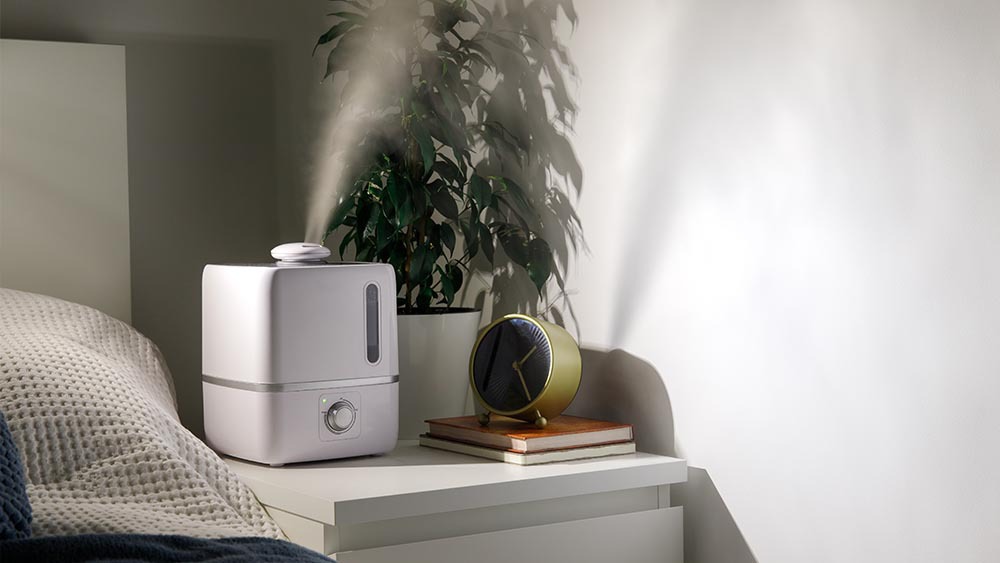
The best place for a humidifier in your bedroom is the center. Preferably, it should be 3 feet away from your bed. You can also use a hygrometer to measure the humidity levels in different spots in your room and then place it where the numbers are quite low.
If you have bought a small humidifier solely to help you sleep better and to prevent dry throat in the morning, place it on your bed stand. You can place a towel or a tray underneath your humidifier to prevent any water damage to the furniture. A cool-mist humidifier is a safer option at night to avoid any burn risk. If you want to use a warm mist humidifier at night, make sure it is placed at a safe distance on a stable surface.
Humidifier Placement In the Living Room
If you spend most of your time in your living room, the dry air in that environment can make you susceptible to allergies. A humidifier can help add moisture to the air, helping to manage your ideal humidity levels. To get an even moisture distribution, you should put your humidifier in the center of your living room. Also, consider the size of your room and humidifier. A large humidifier in a small room will result in fungus and mold growth.
Where to Place a Humidifier in a Baby’s Room?
Humidifiers can be a great addition to your kids’ rooms to prevent allergies and dry skin. Opt for a cool-mist humidifier for your kids’ room to prevent unwanted incidents.
When putting a humidifier in a nursery, place it 3 feet away from the bed or cot. Since kids meddle around with things, you should place the humidifier at a considerable height where they can’t reach, such as a dresser or a shelf.
Best Place to Put Humidifier in Office
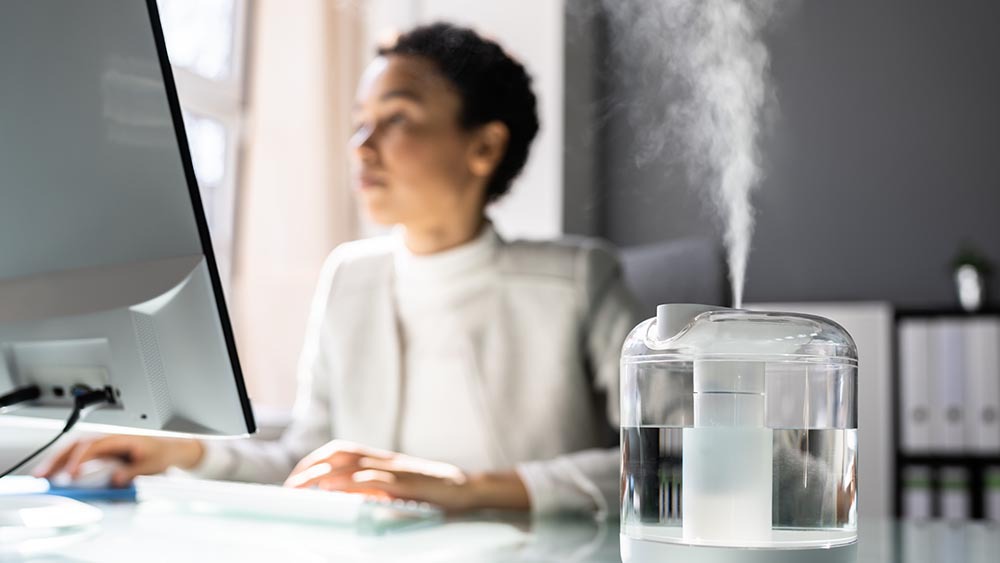
Does dry air irritate you while working? Well, you can purchase a compact humidifier to stay comfortable at your office. It can easily be placed on your work table while increasing the humidity levels in your space. Just ensure that the stream doesn’t blow directly into your laptop or any other equipment.
Placing it on a floor is not a good idea as someone can bump into it while walking, and it will be a mess. Moreover, a humidifier with a quiet operation will work best as you don’t want a loud noise creating a disturbance.
FAQs About Humidifiers
There is a lot more you can do to reap maximum benefits from your humidifier, in addition to the correct placement. Read on to find answers to some of the most frequently asked questions about humidifiers and how you can use them to manage your indoor humidity levels.
Can You Make Your Humidifier Smart?
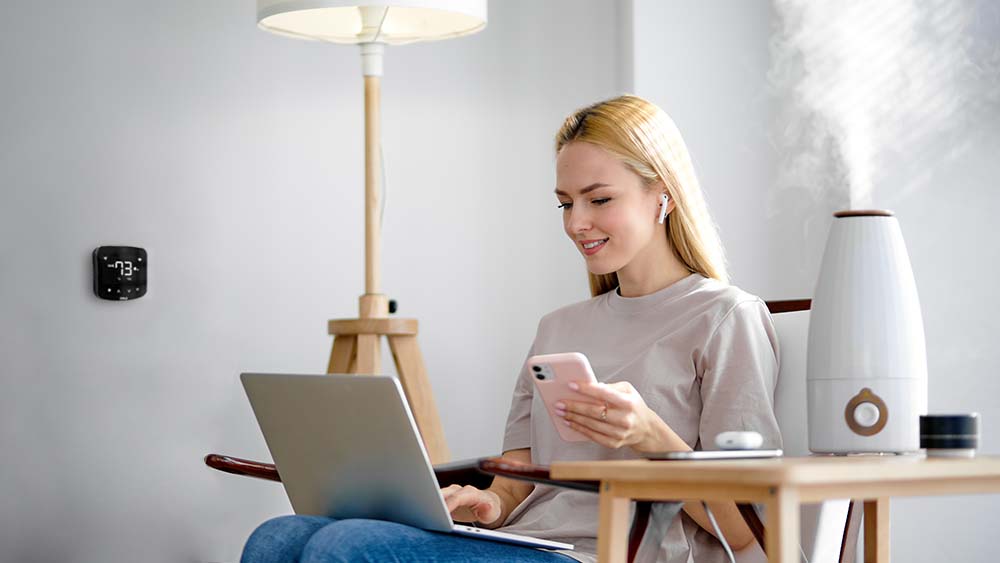
Smart thermostats or smart AC controllers come with humidity sensors. They can be paired with your humidifier (as long as it comes with an IR remote) and help you set humidity triggers to achieve your ideal indoor setting.
Your best choice to make any mini-split, window,
or portable AC smart. Enhance your comfort and savings.

You can control these smart devices using your phone from anywhere in the world. For example, if you are working in an office or are away for shopping, you can view your home’s humidity levels and change the settings accordingly.
Cielo Breez smart AC controllers have a Comfy Mode that allows you to set a specific humidity range. If the levels exceed or fall short of the selected range, the sensors will automatically trigger your desired settings. For example, if you have chosen the range between 30%-50%, the Comfy Mode will turn the humidifier on/off if the levels go below or above these numbers.
Should Humidifiers Be Placed on the Floor or Table?
Placing your humidifier 2-4 feet above the ground is recommended for even moisture distribution. As humidifiers expel moisturized air at the top, it’s necessary to keep a distance of 4 feet below the ceiling to avoid mold growth.
You shouldn’t put it on the floor as you won’t get ample airflow in the upper area, resulting in uneven distribution. Moreover, humidifiers placed on the floors are more prone to spillage, and there are chances of fungus growth if directly placed on a carpet.
Where Should You Not Place Your Humidifier?
You should avoid putting your humidifier near air vents, in direct sunlight, and close to electronic devices.
As humidifiers vaporize water and expel it in the air, placing it near electronic devices can lead to short circuits, which is a safety hazard. Direct sun exposure can result in algae growth inside your water tank. Avoid placing humidifiers close to radiators or vents as hot air can alter the humidity reading, and your humidifier will run for longer than needed.
Putting your humidifier in a corner is also not recommended as it has minimal airflow and will hinder the optimal moisture distribution around your room. Besides, placing it next to a wall can damage the paint and can lead to fungus growth.
Evaporative or Ultrasonic Humidifier – Which One to Use?
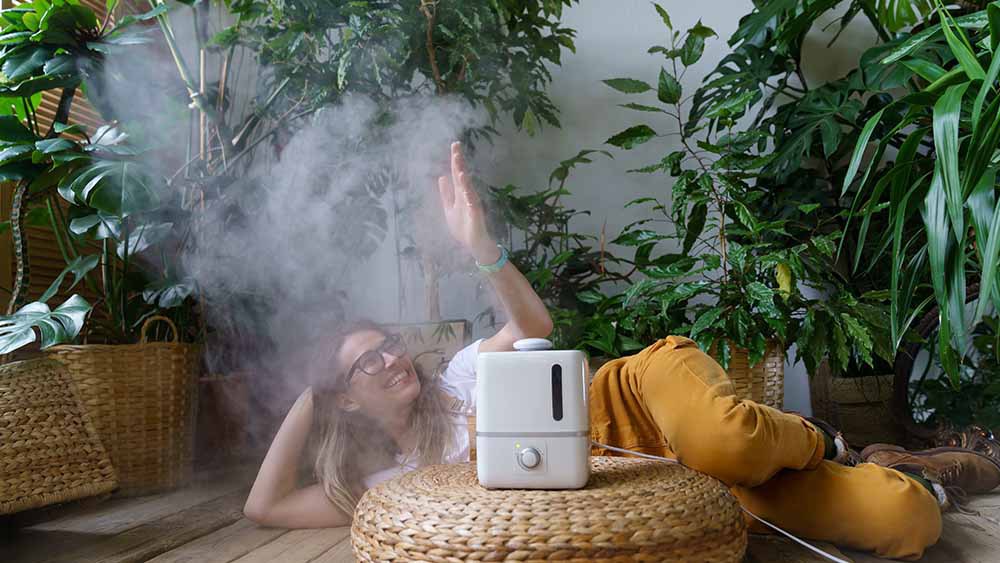
While both evaporative and ultrasonic humidifiers are efficient in adding moisture to the air, the difference lies in how they perform this function.
An ultrasonic humidifier uses high-frequency sound vibrations to produce a fine mist. It has a quieter operation and has no filter. Since it does not require regular filter changing, it is easier to maintain; however, routine disinfection is still required. Without any filters, this humidifier cannot trap minerals, and they can settle around in your room. These humidifiers are also on the pricier side as they use new technology.
An Evaporative humidifier works on the basic principle of evaporation and uses a fan and a wick filter to speed up the evaporation. The wick filter traps the mineral in the water and reduces the risk of white dust circulating in your room but, on the downside, requires routine cleaning. Evaporative humidifiers produce noticeable sound due to fan operation.
If you cannot take time for regular filter changing and want a quiet model, then ultrasonic is a better choice for you. However, if you want a low-cost option that would still get the work done, go for evaporative one.
What is the Best Humidifier Size for Your Room?
Humidifiers are designed to cover a specific area size. Therefore, you need to measure your room size and match it with the humidifier’s capacity to find the perfect size.
If you think the bigger, the better, it’s not true for humidifiers. Placing a large unit in a small room will increase the humidity levels, leading to a musty smell and an overall uncomfortable feeling.
How Often Should You Refill the Tank?
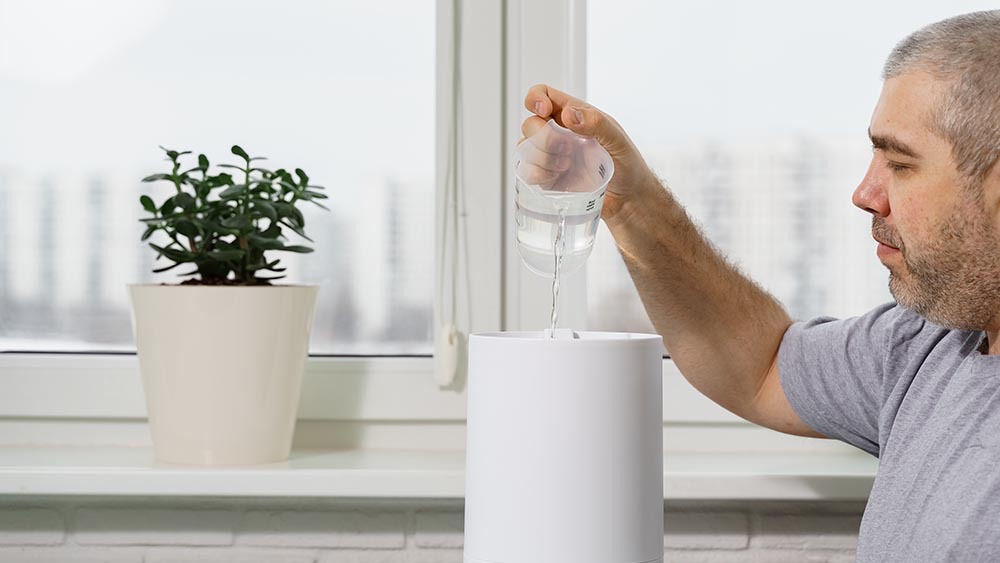
In small, portable units, daily refilling is required. If you are running your humidifier for more than 8 hours, it would require refilling every day. Even a gallon tank humidifier requires daily refills if you use it for a substantial amount of time. Since you’re adding fresh water on a daily basis, this helps prevent bacterial growth as germs breed in stagnant water. Completely emptying the tank, cleaning it with a cloth, and then refilling it with clean water would greatly reduce the growth of germs.
Can You Get a Quiet Humidifier?
All humidifiers make noise that varies by type and model. Ultrasonic humidifiers, for instance, produce considerably less noise than other types. However, you would not find a humidifier that does not produce any sound.
Do You Require In-built Moisture Control?
With in-built moisture control or humidistat, you set your desired range, and the humidifier operates within the range to prevent humidity from exceeding the levels. However, the issue is the in-built controls do not always provide the correct readings.
The best solution is to purchase a hygrometer or a smart AC controller to monitor the humidity levels and then adjust the humidistat according to those levels.
Do Humidifiers Require Maintenance?
Since humidifiers release moisture in the air, they need to be super clean to work effectively. If left uncleaned for longer durations, the water tank can become a breeding ground for bacteria and other germs.
Therefore, its maintenance is crucial. Weekly maintenance is preferred, but that depends on your usage, the mineral content in your water, and how long the water stays in the tank.
If you are looking for a low-maintenance humidifier and have forced-air heating, go for a whole-house humidifier. However, you should note that it requires professional installation and will only work when your heating system is turned on.
How to Clean Your Humidifier?
If you have a portable humidifier, it should be cleaned every third day. For regular maintenance, follow these steps:
- Unplug your humidifier and remove the tank.
- Empty the water tank and use a soft brush to scrub the mineral deposits. If the deposited film is hard to remove, put the white vinegar and water mixture in the tank and leave it for 15-30 minutes. The deposits will easily come off, and you can remove them with a microfiber cloth.
- Use vinegar mixture to clean all the areas that come into contact with water. Soak them for around 15 minutes.
- You can also use bleach or 3% hydrogen peroxide to disinfect the tank. Be sure to rinse the tank thoroughly after using any disinfecting material to prevent the dispersal of chemicals in the air. Always follow the recommended guidelines on the user manual for the cleaning process.
How Often Should You Clean You Change Humidifier Filters?
As far as filters are concerned, most manufacturers recommend changing them every three months. However, if you use tap water, you may have to replace them more often as the mineral deposit can build up and affect its working. Other factors such as pet dander and smoke can also affect how long the filters last. Moreover, the presence of mold and foul smell are strong indicators that you need to change the filter, regardless of when you changed it last time. If you are looking for washable filters, wick filters are a good option.
Warm or Cool Mist Humidifier: Which One to Use?
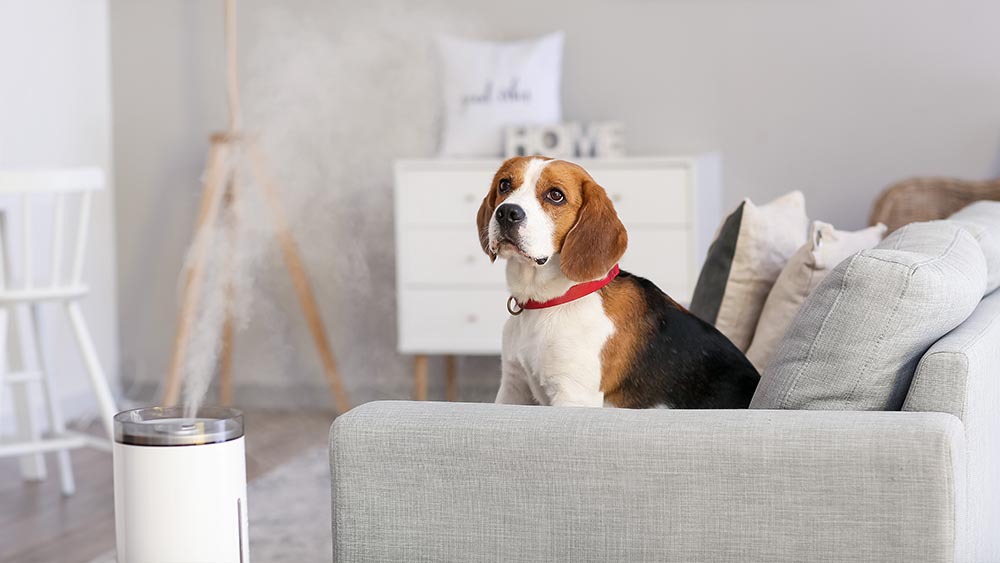
Both warm and cold mist humidifiers have the same function – to increase your home’s humidity levels. Therefore, choosing either one largely depends on your preference.
A cool-mist humidifier is a safer option if you have kids or pets. A warm-mist humidifier may be a risk if accidentally knocked over as it contains hot water in its tank. It also has hot heating elements, which can also pose a risk of burns.
Can You Store Your Humidifier Without Cleaning it?
You shouldn’t store a wet humidifier with a dirty filter as germs easily grow on a damp surface. There is also a health risk if you use an unclean humidifier as bacteria in the tank will spread in the air.
Always disinfect your humidifier with bleach, vinegar, or hydrogen peroxide and dry it completely before storing it in the summer months. To be on the safe side, clean your humidifier again before using in the winter season.
What’s the White Dust Around Your Humidifier?
The white specks are the mineral deposits from the water, and you can easily clean them during maintenance. However, the formation of crusty deposits can become a breeding ground for germs over time.
White dust is usually more common with hard water because of its high mineral content. You can try demineralizing tablets, but that can be costly and is not an effective long-term solution. Using distilled water instead of tap water is the best way to prevent mineral deposits. While distilled water does have minerals, the content is way lower than hard tap water.
Do Humidifiers Come with In-built Bacteria Control Feature?
Some humidifiers do have in-built bacteria control features to reduce the growth of water-borne germs. For example, some use ultraviolet technology to eliminate mold spores, bacteria, and fungi, while others have silver or nanotechnology.
Even with the germ-controlling feature, regular maintenance is still required. In-built bacteria control features are not meant to replace routine cleaning; they are just meant to aid the process.
In Conclusion
Placing your humidifier in the right place will make all the difference in making your home environment comfortable. Put your humidifier in the center of your room on an elevated surface, away from electronic gadgets and direct sunlight. Use a warm mist system with caution and avoid using it near kids and pets. Remember to make your humidifier smart with a smart climate control device as it will help you easily maintain your ideal humidity levels!









3 Comments. Leave new
Can I close the bedroom door when using humidifier? Or I need to leave the door open?
If your humidifier is the right size for your room, it’s best to keep the door closed – you don’t want to strain your humidifier by overextending its capacity. On the other hand, if it’s larger than needed, then opening the door can help release some of that extra moisture.
Should and can you put them directly below a cold air return